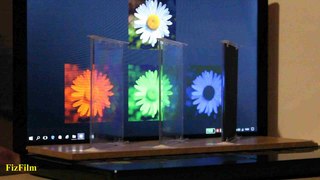
The PDP-1 is the first computer in Digital Equipment Corporation's PDP series and was first produced in 1959. It is famous for being the computer most important in the creation of hacker culture at Massachusetts Institute of Technology, BBN and elsewhere. The PDP-1 is the original hardware for playing history's first game on a minicomputer, Steve Russell's Spacewar!

Portable Network Graphics is a raster-graphics file format that supports lossless data compression. PNG was developed as an improved, non-patented replacement for Graphics Interchange Format (GIF)—unofficially, the initials PNG stood for the recursive acronym "PNG's not GIF".

The RGB color model is an additive color model in which the red, green and blue primary colors of light are added together in various ways to reproduce a broad array of colors. The name of the model comes from the initials of the three additive primary colors, red, green, and blue.

Slow-scan television (SSTV) is a picture transmission method, used mainly by amateur radio operators, to transmit and receive static pictures via radio in monochrome or color.

A framebuffer is a portion of random-access memory (RAM) containing a bitmap that drives a video display. It is a memory buffer containing data representing all the pixels in a complete video frame. Modern video cards contain framebuffer circuitry in their cores. This circuitry converts an in-memory bitmap into a video signal that can be displayed on a computer monitor.
In digital photography, computer-generated imagery, and colorimetry, a grayscale image is one in which the value of each pixel is a single sample representing only an amount of light; that is, it carries only intensity information. Grayscale images, a kind of black-and-white or gray monochrome, are composed exclusively of shades of gray. The contrast ranges from black at the weakest intensity to white at the strongest.

The Game Boy Camera, released as Pocket Camera in Japan, is a Nintendo accessory for the handheld Game Boy game console. It was released on February 21, 1998, in Japan, and manufacturing was ceased in late 2002. As a toy for user-generated content, it can be used to shoot grayscale photographs, edit them or create original drawings, and transfer images between GBC units or to the 64DD art game suite Mario Artist. The accessory featured a 180°-swivel front-facing camera that allowed users to capture selfies. Its images can be printed to thermal paper with the Game Boy Printer. The GBC's cartridge contains minigames based on Nintendo's early games such as the arcade video game Space Fever and the Game & Watch handheld game Ball, and a chiptune music sequencer; photographers have embraced its technological limitations as artistic challenges.

The Aerojet Rocketdyne RS-25, also known as the Space Shuttle Main Engine (SSME), is a liquid-fuel cryogenic rocket engine that was used on NASA's Space Shuttle and is currently used on the Space Launch System (SLS).

The John C. Stennis Space Center (SSC) is a NASA rocket testing facility in Hancock County, Mississippi, United States, on the banks of the Pearl River at the Mississippi–Louisiana border. As of 2012, it is NASA's largest rocket engine test facility. There are over 50 local, state, national, international, private, and public companies and agencies using SSC for their rocket testing facilities.

False color refers to a group of color rendering methods used to display images in color which were recorded in the visible or non-visible parts of the electromagnetic spectrum. A false-color image is an image that depicts an object in colors that differ from those a photograph would show. In this image, colors have been assigned to three different wavelengths that our eyes cannot normally see.

NASA WorldWind is an open-source virtual globe. According to the website, "WorldWind is an open source virtual globe API. WorldWind allows developers to quickly and easily create interactive visualizations of 3D globe, map and geographical information. Organizations around the world use WorldWind to monitor weather patterns, visualize cities and terrain, track vehicle movement, analyze geospatial data and educate humanity about the Earth." It was first developed by NASA in 2003 for use on personal computers and then further developed in concert with the open source community since 2004. As of 2017, a web-based version of WorldWind is available online. An Android version is also available.
An image file format is a file format for a digital image. There are many formats that can be used, such as JPEG, PNG, and GIF. Most formats up until 2022 were for storing 2D images, not 3D ones. The data stored in an image file format may be compressed or uncompressed. If the data is compressed, it may be done so using lossy compression or lossless compression. For graphic design applications, vector formats are often used. Some image file formats support transparency.
Earth Satellite Corporation (EarthSat), an American company, was a pioneer in the commercial use of Earth observation satellites. Founded in 1969, EarthSat was first headquartered in Washington, D.C., and later moved its offices to Bethesda, Maryland, and finally to Rockville, Maryland, in the late 1980s. In 2001, EarthSat was acquired by MacDonald, Dettwiler and Associates Ltd. (MDA) of Vancouver, British Columbia. In August 2005, EarthSat was incorporated as MDA Federal Inc., the U.S. operation of MDA Geospatial Services.

Digital photography uses cameras containing arrays of electronic photodetectors interfaced to an analog-to-digital converter (ADC) to produce images focused by a lens, as opposed to an exposure on photographic film. The digitized image is stored as a computer file ready for further digital processing, viewing, electronic publishing, or digital printing. It is a form of digital imaging based on gathering visible light.
The following are common definitions related to the machine vision field.

The J-2X is a liquid-fueled cryogenic rocket engine that was planned for use on the Ares rockets of NASA's Constellation program, and later the Space Launch System. Built in the United States by Aerojet Rocketdyne (formerly, Pratt & Whitney Rocketdyne), the J-2X burns cryogenic liquid hydrogen and liquid oxygen propellants, with each engine producing 1,307 kN (294,000 lbf) of thrust in vacuum at a specific impulse (Isp) of 448 seconds (4.39 km/s). The engine's mass is approximately 2,470 kg (5,450 Lb), significantly heavier than its predecessors.

Arthur Eugene "Gene" Goldman is the executive director for Aerojet's Southeast Space Operations division. Before retiring from NASA in August 2012, he last served as acting director of the Marshall Space Flight Center located in Huntsville, Alabama. He was appointed as acting director effective March 5, 2012, following the promotion of the previous director, Robert M. Lightfoot, Jr., to Acting Associate Administrator of NASA.
Pacific Cyber/Metrix, Inc. was an American computer company based in California. The company was founded in 1975 in San Ramon, California.

Parallax Graphics, Inc., was an American developer and manufacturer of high-specification computer graphics cards for various platforms, and of supporting software. The company was founded in 1982 as Parallax Systems by two Cornell University graduates.

Martin Research Ltd., later Qwint Systems, Inc., was an American computer company founded by Donald Paul Martin in Northbrook, Illinois, United States. The company released their Mike family of modular kit microcomputers starting in 1975. These computers, spanning several models based on the Intel 8008, 8080, and Zilog Z80 microprocessors, proved very popular among hobbyists who wanted an inexpensive trainer computer.















